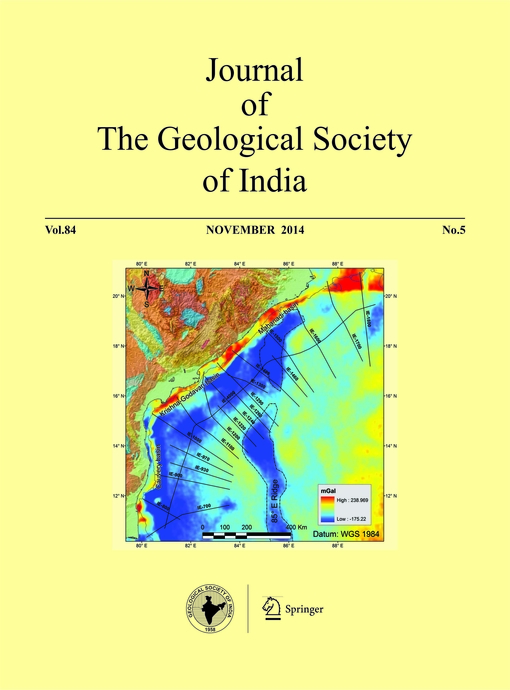2D Resistivity Imaging for Delineation of Waterlogged Coal Workings in Unapproachable Underground Coal Mines to Check Inundation Hazard
Keywords:
Inundation, Resistivity Imaging, Pole-Pole, Abandoned, Waterlogged.Abstract
2D Resistivity Imaging survey is a relatively a new technique used for detecting old, abandoned & unapproachable waterlogged areas in underground mines in recent years. Hingir Rampur Colliery of Mahanadi Coalfields Limited (MCL) was facing problem due to presence of unapproachable underground waterlogged coal workings. Mine management was extracting coal in Seam I of Hingir Rampur seam (HR Seam) at the depth of 100 m. As they had planned to progress the workings of Seam I towards waterlogged goaves of 9 & 11 pits, they proposed to explore the status of waterlogged workings between Seam I of Hingir Rampur colliery and waterlogged goaves of 9 & 11 pits so that they could leave at least 60 m coal barrier from the waterlogged area to check inundation hazard.
For this purpose, Resistivity Imaging (RI) survey were conducted along the six profiles A, B, C, D, E and F in Hingir Rampur colliery in the proposed area for exploration of the waterlogged workings between Seam I and waterlogged goaves of 9 & 11 pits. Pole-pole array of RI survey was used in this study. Considering the indirect approach of geophysical methods, two boreholes (CMRI-31 & CMRI-32) were being drilled along the profiles D and F to confirm the RI data, which were nearer to the coal extraction site. After correlating and corroborating of borehole data with RI data, it was confirmed that strata were hard, compact and dry at 60 m from the surface and continued up to 146 m depth. Hence, it was concluded that mining can be done safely at the depths varying from 100 m to 146 m.
Downloads
Issue
Section
Downloads
Published
How to Cite
References
Batayneh, A. and Al-Zoubi, A. (2000) Detection of a solution cavity adjacent to a highway in southwest Jordan using electrical resistivity methods. Jour. Enviorn. Engg. Geophhys., v.5, pp.25-30.
DANIELS, F. and ALBERTY, R.A. (1966) Physical Chemistry. John Wiely and Sons, Inc.
DIMRI, V.P. (1992) Deconvolution and Inverse Theory: Application to geophysical problems, Elsevier Science Publishers, Amsterdam, 230p.
DIMRI, V.P., SRIVASTAVA, RAVI, P. and VEDANTI NIMISHA (2012) Fractal models in exploration geophysics. Elsevier, USA, 159p.
DUTTA, N., BOSE, R. and SAIKIA, B. (1970) Detection of solution channels in limestone by electrical resistivity method. Geophys. Prospect., v.18, pp.405-414.
Griffiths, D.H. and Barker, R.D. (1993) Two-dimensional resistivity imaging and modeling in areas of complex geology. Jour. Appld. Geophys., v.29, pp.211-226.
JOHNSON, WILLIAM J., D'APPOLONIA, MONROEVILLE, P.A. (2003) Applications of the electrical resistivity method for detection of underground mine workings, Geophysical Technologies for Detecting Underground Coal Mine Voids, Lexington, KY, July 28-30, 2003.
KELLER, G.V. and Frischknecht, F.C. (1966) Electrical methods in geophysical prospecting. Pergamon Press Inc., Oxford.
LOKE (2000) A Practical Guide to 2D and 3D Electrical Imaging Surveys. Published at www.geoelctrical.com.
MILITZER, H., ROSLER, R. and LOSCH, W. (1979) Theoretical and experimental investigations for cavity research with geoelectrical resistivity methods. Geophys. Prospect., v.27, pp.640-652.
PANNO, S., WIEBEL, C., HEIGOLD, P. and REED, P. (1994) Formation of regolith-collapse sinkholes in southern Illinois: interpretation and indentification of associated buried cavities. Jour. Enviorn. Geol. v.23, pp.214-220.
SINGH, K.K.K., LOKHANDE R.D., PRAKASH, A. and SINGH, K.B. (2004) Multielectrode Resistivity Imaging Technique for the study of coal seam. Jour. Scienti. Indus. Res.,v.63, pp. 927-930.
SMITH, D. (1986) Application of the pole-dipole resistivity technique to the detection of solution cavities beneath highways. Geophysics, v.51, pp.833-837.
VERMA, R.K. and BHUIN, N.C. (1979) Use of Electrical Resistivity Methods for study of coal seam in parts of Jharia Coalfield, India. Geoexploration, v.17, pp.163-176.
VINCENZ, A. (1968) Resistivity investigations of limestone aquifers in Jamaica. Geophysics, v.33, pp.980-994.

 K. K. K. Singh
K. K. K. Singh


